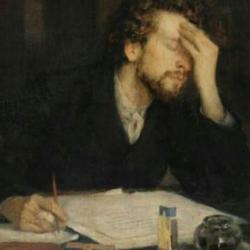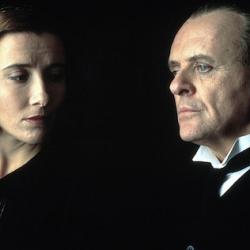Still more.
ACT 1, SCENE 1
Several things about the first scene are worth examining. First, the play begins on a cold and bitter night on the ramparts of Elsinore. The darkness provides a fitting setting for the revelation that the world is out of joint, that something is rotten in the state of Denmark. Beneath the brightly lit exterior that Claudius invents is the darkness of murder and incest.
Second, the play begins with a series of interruptions, which take the form of a series of demands for identification: “Stand and unfold yourself” and “Stand, ho! Who is there?” (1.1.3, 14). Barnardo is interrupted in his watch by Francisco, and those two by the entry of Horatio and Marcellus. Barnardo begins to describe the ghost’s appearance with a speech that is remarkably leisurely (1.1.35ff), but his story is interrupted by the ghost. When Horatio begins to describe the meaning of ghosts and portents, the ghost interrupts again (1.1.112-125). Just as the ghost appears to be beginning to speak, he is interrupted by the cock crow, and steals away like a guilty thing (1.1.138, 148). This is a world where things can erupt into the characters’ consciousness at a moment’s notice, things like the corpses of departed kings that usually stay safely out of sight and of mind. Claudius is insensible of this reality in Denmark – there is nothing he cannot handle he believes, and he tries to convince his court to believe the same (1.2.1ff). The play opens by dramatizing the reality of Hamlet’s words to Horatio: There’s more in heaven and earth than are dreamed of in your philosophy. The opening scene also set the grammatical mood of the play, the riddling interrogatives that Maynard Mack pointed to in his famous essay on Hamlet.
Third, the ghost makes his first appearance in scene 1, and is a central presence in the play. But the ghost is thoroughly ambiguous, a fact that provides at least a partial explanation for Hamlet’s hesitations. As Peter Saccio has argued, there were various theories among Elizabethans concerning ghosts. Catholics believed that ghosts were spirits from Purgatory, sent to deliver messages to the living; Protestants believed that ghosts were from either heaven or, more likely, hell; and skeptics believed that ghosts were hallucinations induced mainly by melancholy. Each of these theories is present in the play. The soldiers who have seen the ghost are convinced of its reality, though they have no explanation for it. Horatio, trained as a Humanist (and perhaps as a Protestant) at the new German university of Wittenberg, is initially a skeptic (“Tush, tush, ‘twill not appear” is almost his first line), but as soon as he sees the ghost he knows that it is more than soldiers’ fantasy. He knows enough lore to recognize that it is a portent of evil: It “bodes some strange eruption in our state” (1.1.69), just as the appearance of the dead in the streets of Rome heralded the death of Julius Caesar (1.1.112ff).
Hamlet initially reacts with a horrified prayer for angelic protection (1.4.39), and considers later that the ghost may be a devil sent to tempt him to damnation (2.2.537ff) – a good Protestant thought. The ghost himself describes a place of temporary torment and explicitly speaks of a process of purgation (1.5.9ff). Stephen Greenblatt offers other evidence that the ghost comes from Purgatory: Hamlet urges the ghost to rest (1.5.183), a Catholic rather than a Protestant sentiment; he invokes St Patrick, the patron saint of Purgatory (1.5.139-42); Hamlet’s strange “hic et ubique” to the ghost (1.5.158) may be taken from a prayer to be performed in a churchyard that relieves the one praying from as many years of Purgatory as there are bodies buried in the yard (“Avete, omnes animae fideles, quarum corpora hic et ubique requiescunt in pulvere” – Hail all faithful souls, whose bodies here and everywhere do rest in the dust). Greenblatt suggests that Hamlet is a man of Protestant temperament haunted by a Catholic ghost – perhaps emblematic of a temperamentally Protestant Britain haunted by its Catholic past.
As Greenblatt says, “The trouble is that Purgatory, along with theological language of communion (houseling), deathbed confession (appointment), and anointing (aneling), while compatible with a Christian (and, specifically, a Catholic) call for vengeance, is utterly incompatible with a Senecan call for vengeance. Such a call for vengeance – and Hamlet understands that it is premeditated murder, not due process, that is demanded of him – could only come from the place in the afterlife where Seneca’s ghosts reside: Hell.” Greenblatt says that the ambiguity of the ghost is deliberate, consistent with “a deliberate forcing together of radically incompatible accounts of almost everything that matters in Hamlet.” Yet, in addition to the fact that the ghost calls for vengeance, there is other evidence that the ghost is a hellish messenger. During his first appearance, he leaves when the cock crows, herald of morning and light, like a “guilty thing.” This is not a passing point: Marcellus goes on at length about how the crowing of the cock during Advent hallows and graces the time (1.1.157), leading at least one commentator to suggest that scene 1 is an inversion of the story of the angel’s appearance to the shepherd at Christmas (here, the appearance of a ghost heralds not the birth of a son but the death of a father, and the eventually death of the son as well; not peace on earth good will to men, but something rotten in the state of Denmark).
ACT 1, SCENE 2
The tone and feel of scene 2 could hardly be more different from that of scene 1, a shift well captured in the bright, colorful space of Elsinore’s court in Branagh’s film version of Hamlet. Night has yielded to day; outside to in; cold to warmth; the ghost of a dead king to the living body of a new king; the staccato speeches of the cold, frightened soldiers to the flowing and almost-convincing rhetoric of a master politician.
Horatio has already introduced us to the political situation, the threat from Norway, and if we knew nothing of the subsequent play we would think that the ghost was a portent of Norway’s victory. The discussion of Fortinbras here and in scene 1 are significant on two levels: First, because Fortinbras is the first vengeful son we meet in the play, and second because Claudius’ dismissal of his threat shows how little Claudius understands of his own danger. Claudius spends no time considering that possibility that Fortinbras is a real threat; there is nothing in heaven or earth or hell than cannot be encompassed in his policy. Claudius lives in a world of appearances, image, seeming – again nicely captured by Branagh’s film with the use of mirrors. Of course, Fortinbras takes Claudius’ throne at the play’s end, another unexpected interruption of the apparent stability of Denmark.
This is Hamlet’s first appearance on stage, and it sets the trajectory for our responses to him throughout the play. His first words are a bitter pun: “More than kin” because the man who had been his uncle has become his father; “less than kind” because he has acted with unnatural haste in marrying Gertrude and because Hamlet distrusts Claudius’ displays of affection toward him. His second line is also a pun on sun/son. His first speech is a philosophical discussion of appearance and reality, centered on the image of acting (“actions that a man might play”). From his first lines, we have a clear initial portrait of Hamlet: He is clever, perhaps too clever; bitterly angry at least at Claudius for reasons that are not yet revealed; grief-stricken at least at the death of his father.
Mack has noted that the
imagery of playing, acting, showing are woven throughout Hamlet: “‘Show’ seems to be Shakespeare’s unifying image in Hamlet. Through it he pulls together and exhibits in a single focus much of the diverse material in his play. The ideas of seeming, assuming, and putting on; the images of clothing, painting, mirroring; the episode of the dumb show and the play without a play; the characters of Polonius, Laertes, Ophelia, Claudius, Gertrude, Rosencrantz and Guildenstern, Hamlet himself – all these at one time or another, and usually more than once, are drawn into the range of implications flung round the play by ‘show.’” Further, the play probes the issue of acting, and the related question of action: “What, this play asks again and again, is an act? What is its relation to the inner act, the intent?” All these themes, key words, images are thrown up by the initial speech of Hamlet. If his first speech initiated the interconnected themes of seeming/being, acting/showing/playing, his first soliloquy points to his disgust at the world, mainly a result of his mother’s “frailty” and unfaithfulness. Hamlet’s world is a fallen Eden, an unweeded garden, full of things rank and gross; something is rotten in the state of Denmark, and Hamlet feels that rottenness and embodies the “isness” of the rottenness within the image-world of Claudius.
Greenblatt sees in Hamlet’s soliloquy the first stirrings of a revulsion toward flesh, which complicates his task. Commenting on 3.3.80-81, Greenblatt writes, “Hamlet is disgusted by the grossness whose emblem here is the bread in his father’s stomach, a grossness figured as well by drinking, sleeping, sexual intercourse, and above all perhaps by woman’s flesh. The play enacts and reenacts queasy rituals of defilement and revulsion, an obsession with a corporeality that reduces everything to appetite and excretion.” Yet, this turning from the flesh is ultimately “the spiritual precondition of a liberated spirit that finds a special providence in the fall of a sparrow, sacrificially fulfills his father’s design, and declares that the readiness is all.” Here again, the text of Hamlet may be playing on debates among Catholics and Protestants – specifically about the Mass, according to Greenblatt. The disgust that Hamlet feels toward materiality is also consistent with his desire to know something of what happens on the other side of the grave, ignorance of which sicklies action with hesitating thought.
ACT 1, SCENE 3
In the middle of scene 2, another interruption: Hamlet’s meditations are cut short by the appearance of Horatio and the soldiers – effectively another appearance of the ghost. And then the time between is taken up with another interruption, as Laertes takes his leave of Polonius and Elsinore. He instructs Ophelia not to trust Hamlet’s professions of love, emphasizing that Hamlet must listen more to the demands of the body politic than to the urges and desires of his own body (1.3.22-23). Polonius’ speech contains advice to Laertes as he leaves. Though Polonius is often treated as a buffoon, the placement of this scene has more the effect of setting the affectionate home of Polonius in contrast with the embittered royal house. Laertes will return to avenge his father; Hamlet will be soon considering how best to kill his father-uncle.















